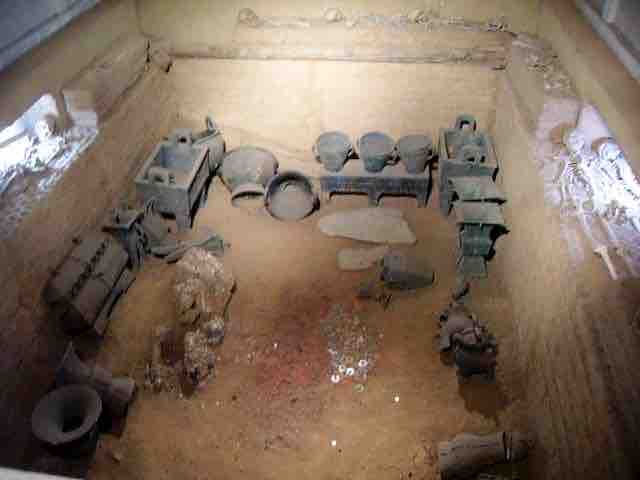Overview: Shang Dynasty
The Shang Dynasty, also known as the Yin Dynasty, according to traditional historiography, ruled in the Yellow River valley in the second millennium BCE. According to various chronologies and research, the Shang are estimated to have succeeded the previous Xia Dynasty from c. 1766-1556 BCE, and they are estimated to have ruled until the following Zhou Dynasty c. 1122-1046 BCE.
Artifacts from the Shang Dynasty
The artwork of the Shang Dynasty has been discovered through numerous archaeological digs. In particular, archaeological work at the Ruins of Yin, identified as the last Shang capital, uncovered eleven major Yin royal tombs and the foundations of palaces and ritual sites containing both weapons of war and the remains from animal and human sacrifices. Tens of thousands of bronze, jade, stone, bone, and ceramic artifacts have been obtained. The workmanship on the bronzes attests to a high level of civilization.
Many Shang royal tombs had been tunneled into and ravaged by grave robbers in ancient times; however, in the spring of 1976, the discovery of Tomb 5 at Yinxu revealed a tomb that was not only undisturbed, but one of the most richly furnished Shang tombs that archaeologists had yet come across. With over 200 bronze ritual vessels and 109 inscriptions of Lady Fu Hao's name, archaeologists realized they had stumbled across the tomb of the militant consort to King Wu Ding, as described in 170 to 180 Shang oracle bones. Bronze vessels, stoneware and pottery vessels, bronze weapons, jade figures, hair combs, and bone hairpins were found.

Tomb of Fu Hao
With over 200 bronze ritual vessels and 109 inscriptions of Lady Fu Hao's name, archaeologists realized they had stumbled across the tomb of the militant consort to King Wu Ding, as described in 170 to 180 Shang oracle bones.
Ceramic and Bronze Work
Chinese bronze casting and pottery greatly advanced during the Shang dynasty, with bronze often being used for art as well as for weapons. Shang era ceramics grew more detailed during this era as technical skill advanced, though they did not yet reach the technical skill of the following Han Dynasty. Various excavations have yielded pottery fragments containing short sequences of symbols, suggesting early forms of writing that differed across regions. The Shang had a fully developed system of writing, preserved on bronze inscriptions and a small number of other writings on pottery, jade, horn, and oracle bones.
White pottery pot with geometric design, Shang dynasty (1600–1100 BC)
As far back as c. 1500 BCE, the early Shang Dynasty engaged in large-scale production of bronzeware vessels and weapons. This production required a large labor force that could handle the mining, refining, and transportation of the necessary copper, tin, and lead ores. This, in turn, created a need for official managers that could oversee both hard-laborers and skilled artisans and craftsmen.
The Shang royal court and aristocrats required a vast amount of different bronze vessels for various ceremonial purposes and events of religious divination. Ceremonial rules even decreed how many bronze containers of each type a nobleman or noblewoman of a certain rank could own. Bronze was also used for the fittings of spoke-wheeled chariots, which appeared in China around 1200 BCE.
A Shang dynasty bronze ding vessel
The Shang royal court and aristocrats required a vast amount of different bronze vessels for various ceremonial purposes and events of religious divination.
With the increased amount of bronze available, the army could also better equip itself with an assortment of bronze weaponry. Bronze weapons were an integral part of Shang society, and Shang infantry were armed with a variety of stone and bronze weaponry, including máo (矛) spears, yuè (鉞) pole-axes, gē (戈) pole-based dagger-axes, composite bows, and bronze or leather helmets.
A bronze axe of the Shang dynasty
Bronze weapons were an integral part of Shang society, and Shang infantry were armed with a variety of stone and bronze weaponry.